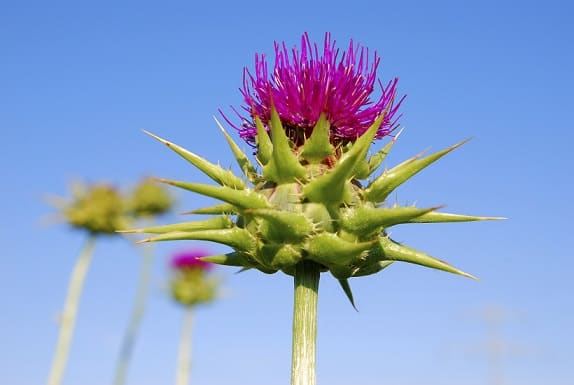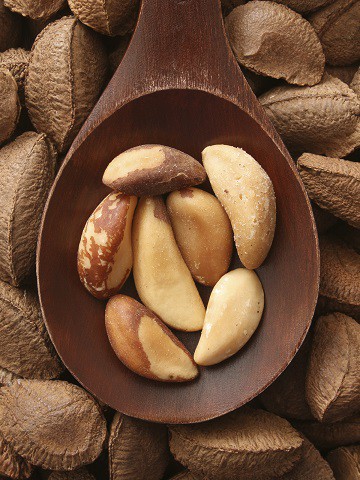Milk thistle, or Silybum marianum, is a purple plant with brutally sharp spikes, which has been used as a herbal supplement for at least 2000 years.
Ancient people used it as an antidote for snake bites and poisonous toadstools, while nowadays, the extract is most famous as a liver shield. Milk thistle can supposedly regenerate your liver cells in the face of killers like cirrhosis, fatty liver disease, and hepatitis B and C.
Bodybuilders are also fans, using milk thistle for detox support when blasting their livers with oral steroids, which are notoriously hepatoxic.
Not surprisingly for a detox herb, there’s a ton of online acne patients who swear by milk thistle. The classic testimonial is a handful of initial breakouts, which suddenly evaporate at the two week mark to reveal a face clearer than it’s been in years.
Are milk thistle’s acne powers real, or like the infamous chlorophyll, is it an overhyped waste of time and money?
Milk thistle antioxidant slashes acne severity by 50%
Firstly, like any famous acne plant, milk thistle has its own signature compounds, and they are silymarin and silbinin.
You might see this duo discussed on acne forums as isolated supplements, because it’s these compounds that accelerate your detoxification systems. In fact, almost every milk thistle bottle nowadays displays the silymarin percentage in big, booming letters; products that forget to are normally bombarded by confused customer questions.
Here’s why silymarin is so important. A recent 2012 study wanted to discover the truth about oral antioxidants once and for all. Hence, 56 acne patients were divided into four groups. They received either 200mcg of selenium, 1200mg of n-acetyl-cysteine, 210mg of silymarin from milk thistle, or an inert placebo.
What happened next? Not surprisingly, acne counts barely budged in the placebo group. Total acne lesions in the selenium patients fell by nearly 40%, which is pretty respectable…
…but the selenium couldn’t match the fantastic results of milk thistle. In both the silymarin and NAC-receiving groups, total acne lesions fell by a massive 50%.
Seeing as the milk thistle seed is 4-6% silymarin by weight, and its absorption into the body is generally very strong, that’s rock solid evidence for milk thistle right there.
Milk thistle boosts your glutathione production
We also know the explanation for these acne miracles, as the study found that bloodstream glutathione increased by a staggering 271%. A separate study was similar, finding that milk thistle boosted glutathione by 50% in the lungs.
Glutathione is the single most important antioxidant that your body manufactures itself. Acne patients were once shown to have 20% less in their skin than normal people. It’s your body’s most important detoxification agent, and boosting glutathione is also the key to milk thistle’s liver healing secrets.
Read Annihilate Your Acne – learn to prevent acne and stop just treating it!
Alcoholics, for example, are routinely prescribed milk thistle. Why? Because when alcohol is metabolised by the liver, it generates a dangerous by-product called acetaldehyde, a substance 30 times more toxic than alcohol itself. It’s acetaldehyde which unleashes the pounding headaches and zombie-like fatigue of a bad hangover, and it’s also responsible for weakening and fatally scarring liver cells over the long term.
Glutathione is the detoxification agent tasked with removing this acetaldehyde. Most importantly for acne, glutathione can detoxify all sorts of other contaminants, and by extension, so might the milk thistle herb.
The real role of toxins in acne
There’s a tidalwave of hype these days about hidden toxins and their link to acne outbreaks. For example, you should never believe that a crippled liver diverts toxins to the skin, where they exit your body through your pores and slowly accumulate in them. Nor should you believe that toxins are stashed away in the liver itself, and that to cure acne permanently, you have to perform a crazy liver cleanse by eating nothing but raw kale for two weeks.
That said, optimising your detoxification systems does allow you to banish acne-causing toxins more effectively, and glutathione is utterly vital. As an example, it detoxifies the heavy metals mercury and arsenic, by transferring a molecule to them, preventing them from reacting with cells.
Mercury triggers acne via massive inflammation, and arsenic is notorious for increasing keratin and dead skin cell turnover. Without deep and plentiful glutathione stocks, such acne villains can be endlessly recycled back into the bloodstream.
Recommended – the 7 greatest natural topical treatments for acne
Perhaps the biggest quandary of all is glutathione’s dual function. If glutathione is constantly side-tracked with toxins flooding in, then your levels will inevitably be depleted. With it, you’ll lose glutathione’s important antioxidant functioning, its defensive powers against air pollution, cigarette smoke and other free radicals.
Here in the 21st century, we are exposed to more hidden toxins than ever, whether it’s parabens in makeup or aluminium in deodorant. Our glutathione reserves are under constant, subtle attack, and that’s why a carefully placed milk thistle pill could work wonders for acne.
Why milk thistle isn’t at all necessary
You might be surprised to hear then, that I don’t automatically recommend milk thistle for acne. Why? Because its importance is dwarfed by numerous other glutathione-boosting strategies.
Selenium was once found to slash acne lesions in nearly all patients. Unlike silymarin, selenium is an essential dietary mineral and a fundamental ingredient of glutathione. It’s a precursor to 5 out of 8 forms: GPX-1, GPX-2, GPX-3, GPX-4 and GPX-6.
The chance of benefits is huge, because acne patients generally have lower levels than average. The same is true for zinc, another important glutathione precursor. In this study, a group of rats receiving zinc supplements had the highest glutathione levels with ease. Another study found that 54.1% of acne patients were zinc deficient compared to must 10% of clear-skinned people.
Why bread and pasta are a massive cause of acne
The bottom line is that silymarin won’t get you far if you’re missing the basic glutathione co-factors. Milk thistle provides a big bonus, certainly, but selenium, zinc and also magnesium are fundamental. Likewise, glutathione is fundamentally a sulphurous compound, and adding sulphurous foods like garlic, onions or even plain old broccoli can perform magic tricks.
Milk thistle does send your glutathione soaring, but it’ll never beat taking glutathione’s essential ingredients.
Side effects – not guaranteed, but possible
Furthermore, milk thistle has a very real risk of side effects, which are notoriously hard to predict.
Loss of appetite is a particular staple, as is unbeatable insomnia. One internet dweller “used to be able to sleep 8 hours a night easily; now I wake up after four hours and can’t get back to sleep“. Insomnia is dire news for acne patients because sleep deprivation is the enemy of insulin sensitivity. The guy also noticed hair loss, and later filed an update where his hair loss had “accelerated at a crazy rate“.
Contrary to what some websites are saying, milk thistle does not give you breast cancer. The seeds contain potent natural estrogens which activate estrogen receptors as effectively as the dread soy isoflavones, but luckily, this is counteracted by milk thistle’s wider benefits for hormone metabolisation. This study observed increased clearance of estrogen overall.
Now that we’ve shattered the illusion of that myth, milk thistle still has numerous side effects and a very real one is reduced sex drive. One user’s “libido and sexual function generally declined” and apparently, milk thistle can both block androgen receptors (study) and raise prolactin, the milk-making hormone which suppresses testosterone.
Somehow though, others have reported a surging increase in libido. Likewise, some users have enjoyed a ravenous appetite. Individual reactions vary massively with milk thistle – it depends on your body.
Nevertheless, it’s telling that doctors always advise alcoholics or cirrhosis patients to limit milk thistle to two or three week cycles. Milk thistle can actually increase your liver enzymes when taken for too long (that sounds good, but it’s bad).
Selenium and milk thistle have the same power for acne, but the former’s dangers occur at huge dosages, while the latter’s occur at random.
Bonus benefits
Milk has two complimentary weapons against acne which are similarly promising. Firstly, this study on oral milk thistle pills found a nice reduction in the pro-inflammatory master molecule NK-KappaB, which controls the release of many smaller immune system chemicals behind acne. That’s an excellent power to have, but it’s also found elsewhere, like in sweet potatoes, garlic, bananas, resveratrol and vitamin D.
Why zinc is the number one supplement for red and inflamed acne
Secondly, the enhanced metabolisation of hormones discussed earlier could help to reduce unhealthy estrogen metabolites, namely 4-hydroxy and 16-hydroxyestrone. These misbehaving offshoots can trigger pimples via oxidative stress and inflammation…
..but if your goal is to optimise estrogen, then you’d be far wiser to experiment with indole-3-carbinol/DIM, which has a vastly superior track record for hormonal acne.
Both powers are identical to the glutathione increase: fairly promising, but common enough that milk thistle is relegated to a mere bonus supplement.
If you don’t care about this negativity and want to experiment for yourself, then this Pure Synergy Organic Milk Thistle Extract (amazon link) is the best brand available.
Conclusion
There’s no doubt that milk thistle works wonders for liver health. Silymarin and silbinin have the power to increase protein recruitment and accelerate the birth of healthy new liver cells, even in scarred livers wrecked by cirrhosis. One study on human showed protection against liver damage from solvents, paints and glues, and decreases in total liver enzymes (good). Milk thistle now boasts 450 liver protecting studies to its name.
The problem is that the one such liver power which translates to clear skin, the surge in glutathione, can be obtained elsewhere with ease. I would never recommend milk thistle before selenium or zinc. Those minerals are the essential ingredients, and are even proven to clear acne (by 49.8% in zinc’s case).
That said, silymarin could conceivably affect certain glutathione pathways which selenium doesn’t. The overall verdict is clear: milk thistle is an unnecessary, but promising experimental acne supplement.
NEXT: read the 167 page eBook and get the ultimate diet for acne
Thanks for reading!


